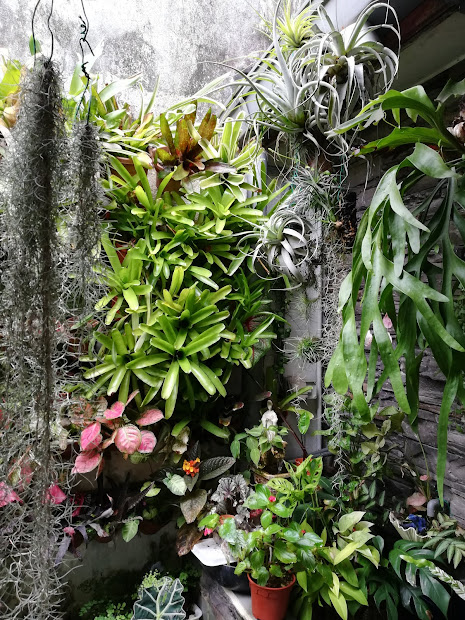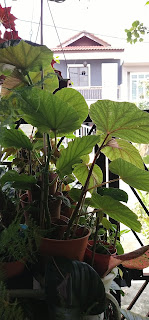Just a little bit of a basic introduction this particular begonia, this is not a common type, I believe is one of the rare ones that is recently been introduced in the local nursery here; uh perhaps about five years ago this is considered one of the exotic ones which is considered very expensive but however now it is very much commonly available though the price is not so cheap however it's very much affordable now compared to a few years ago.
Welcome to my Tropical Garden in Malaysia where the focus is mainly cultivating unique and colorful plants ranging from rare to common plants all around the tropical belt across the world.
Search This Blog
My Vertical Garden Wall

TRASLATION LANGUAGE (CLICK HERE)
Thursday, July 28, 2022
How to Care & Cultivate Begonia Brevirimosa
Just a little bit of a basic introduction this particular begonia, this is not a common type, I believe is one of the rare ones that is recently been introduced in the local nursery here; uh perhaps about five years ago this is considered one of the exotic ones which is considered very expensive but however now it is very much commonly available though the price is not so cheap however it's very much affordable now compared to a few years ago.
Monday, July 25, 2022
How to Safe a Dying Cane Begonia / Repot Rooted Cuttings (Video)
In today's video, I would like to talk about a situation where you would find a cane begonia suddenly dying away. I have experienced many times in a situation where it appears to be a little bit of a mystery to me where a healthy begonia; Cane begonia and that seems to be a little bit like leggy and the leaves tend to drop off and don't look so healthy looking, something similar like the earlier Cane.
okay the other thing that I want to mention to you is I also use chopsticks to straighten the plant, so that it doesn't bend or fall or lose its balance. Eventually these canes will actually grow taller and you can actually replace these bamboo sticks chopsticks with stronger, sturdier sticks for them to take support. Other than that the basic care is very much simple, bright indirect light, uh also watering them with cautions because too much if they are too wet the whole thing can rot away; so just lightly watering them when the medium is slightly dry uh other than that occasionally I would say about once a week a foliar fertilizer on them so that they have enough nutrients and other than that I find that they are actually hardy plants. Another factor that I notice is that they do not have so much of a pest problem, unless uh if they are not placed in an adequate location.
Sunday, July 24, 2022
Cane Begonia Collection: July - Sept 2021 Updates (Part 3)
Cane Begonia Collection: Jan 2022 Updates (Part 2)
Saturday, July 23, 2022
Cane Begonia Collection: July - Dec 2021 Updates
Water only when the Medium is Dry
Foliar Fertilizer - Once a Week with 1/2 Dilution Strength.
Do take note that this one truly hate too much water - the leaves may also change colors, especially turning pale green and the red and burgundy coloration faded. Do take note that if this happens - most likely the plant lifespan is numbered and the eventually leaf by leaf - they start dropping and the rhizome dried up or rotting and it is too late to safe the plant or rectify the problem.
Begonia - U514 (Part 2)
Water only when the Medium is Dry
Foliar Fertilizer - Once a Week with 1/2 Dilution Strength.
Do take note that this one truly hate too much water - the leaves may also change colors, especially turning pale green and the red and burgundy coloration faded. Do take note that if this happens - most likely the plant lifespan is numbered and the eventually leaf by leaf - they start dropping and the rhizome dried up or rotting and it is too late to safe the plant or rectify the problem.
About Me

- James David
- Tropical Garden, Batu Caves, Malaysia
- My Malaysian Tropical Garden mainly focused on unique and colorful plants ranging from rare to common plants all around the tropical belt across the world. Ideal for inspiration for challenging areas in the garden space - indoor gardening, balcony gardening and small green spaces especially for ariods, bromeliads, begonias, edibles, cascading & vertical garden plants, succulents & cacti, orchids, together with both shade and sun loving plants.
Contact Me on the Form Above
Contact Form
Blog Archive
-
▼
2022
(87)
-
▼
July
(14)
- How to Care & Cultivate Begonia Brevirimosa
- How to Safe a Dying Cane Begonia / Repot Rooted Cu...
- Cane Begonia Collection: July - Sept 2021 Updates ...
- Cane Begonia Collection: Jan 2022 Updates (Part 2)
- Cane Begonia Collection: July - Dec 2021 Updates
- Begonia - U514 (Part 2)
- Black Velvet Begonia Collection - Different Cultiv...
- Black Velvet Begonia - Green Cloud Variety - PART 2
- Begonia - U497 (Updated Information)
- Begonia Sinuata (Sparkling Begonia / Maple Leaf B...
- Kebun Longkang Garden Visit with Professor Chan En...
- How to Care & Cultivate Tree Frogs in your Tropica...
- KVPA Plant Acquisition Events List (PEE1 - PEA10) ...
- KVPA Plant Acquisition Event No 8 (#PAE8)
-
▼
July
(14)
Favorite Popular Posts (Please click on links below)
- ANTHURIUM - Different Types with Names & Images
- JEWEL ALOCASIA - Different Types with Names & Images
- ALOCASIA - Different Types with Names & Images
- COLOCASIA (TARO) - Different Types with Names & Images
- BEGONIA - Different Types with Names & Images
- CANE BEGONIA - Different Types & Images
- DIEFFENBACHIA (DUMBCANE) - Different Types with Names & Images
- EPISCIA - Different Types & Images
- FERNS & ALLIES - Different Types (Names & Images)
- HUPERZIA (Tassel Ferns) Different Types - Name & Images
- DISCHIDIA - Different Types with Names & Images
- HOYA - Different Types with Names & Images
- CALLISIA - Different Types & Images
- TRADESCANTIA - Different Types with Names & Images
- INDOOR PLANTS - Different Types & Images
- FRAGRANT FLOWERS - Different Types of Tropical Fragrant Flowering Plants
- KVPA Plant Acquisition #PAE Events List
Popular Posts
-
My Garden is slowly settling to its permanent position where I'm going to maintain what I have currently. The best idea in keepi...
-
I had wanted to list all the begonias and their ID with images here. Somehow it will be overwhelming to put the whole genes here which ...
-
Most of my friends asked me about where I purchase my plants. I often tell them about this very famous nurseries, the ones located in Sg....
-
CANE BEGONIA UPDATE : 9th July 2024 I have found after years of experience that there are difference between Cane Begonia species where ther...
-
INTRODUCTION: To have or not to have. What if all the neighbors around your surrounding area plants this same plant, Would you consider ...
-
I would like to introduce a New Series on Indoor Plants and hope to come up with 10 Best Indoor Plants for Beginners. I'm guessing...
-
I had wanted to list all the Episcia and their ID with images here. Somehow it will be overwhelming to put the whole genes here which will ...
-
It was one of my zealous moments where I have decided to just go and see whats happening in this Orchid Garden. Its situated inside KL Lak...
-
I have come across many gardeners who had stopped gardening for the fear of mosquito's. Though it sound like a laughing matter but not s...
-
This is my collection of Dieffenbachia (Dumbcane) which I had managed to cultivate and grow. Strangely as it may seemed - I find some of the...
Popular Post - 1 Month
-
CANE BEGONIA UPDATE : 9th July 2024 I have found after years of experience that there are difference between Cane Begonia species where ther...
-
I had wanted to list all the begonias and their ID with images here. Somehow it will be overwhelming to put the whole genes here which ...
-
INTRODUCTION: To have or not to have. What if all the neighbors around your surrounding area plants this same plant, Would you consider ...
-
It feels like ages when I actually started this plant from seed to this point when I can finally enjoy the flower. I never imagine the mom...
-
INTRODUCTION: This un-named begonia listed as Begonia U497 was first found and identified in Thailand, supposedly sold in a plant market in ...
-
I had wanted to list all the Episcia and their ID with images here. Somehow it will be overwhelming to put the whole genes here which will ...
-
My Garden is slowly settling to its permanent position where I'm going to maintain what I have currently. The best idea in keepi...
-
Characteristics: This particular one has a heart shaped leaf formation and a vibrant dark purple coloration on it's foliage. Th...
-
What a Long Break : June 2023 - July 2024 From Blogging I'm so surprised that time just few just like that. A lot had happened during th...
-
I have come across many gardeners who had stopped gardening for the fear of mosquito's. Though it sound like a laughing matter but not s...































































